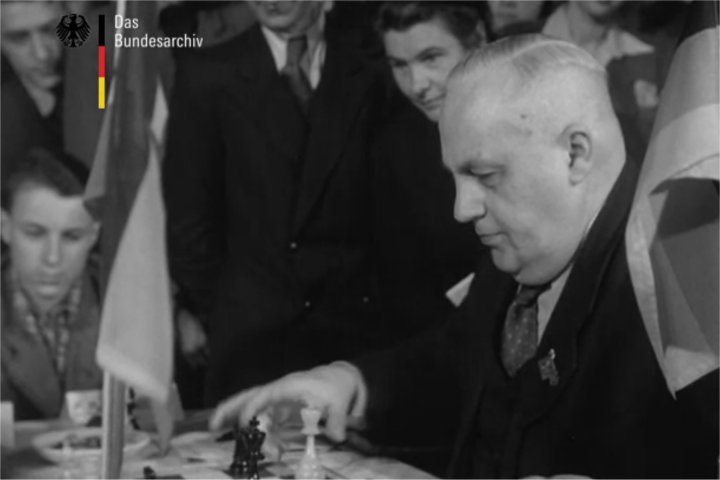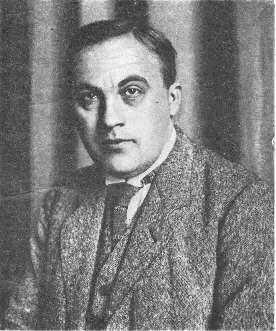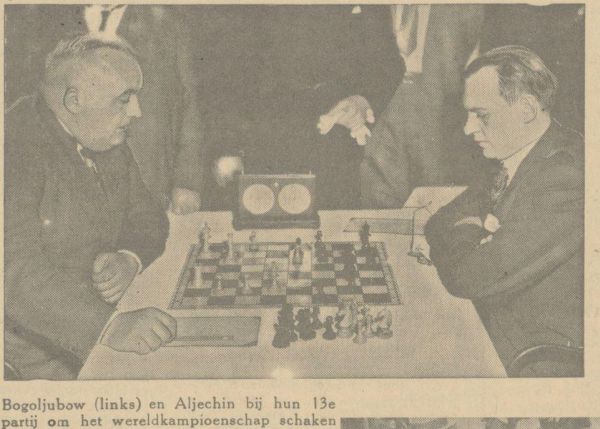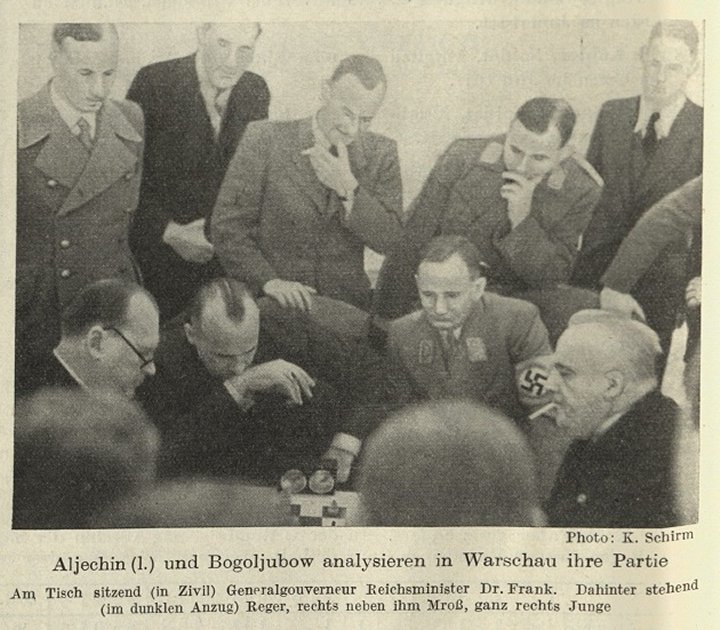


The "Mega" is the database every serious chessplayer needs. The database contains 7.6 million games from 1500 to 2018, in highest quality standard, full of top level analyses and completely classified.
Efim Bogoljubov is one of the best players in the history of chess, but he learnt the game rather late, when he was 15 years old — today, some juniors are already grandmasters at this age. But Bogoljubow was already 18 when he started to get seriously interested in chess. At first, he wanted to become a priest and studied theology in Kiev, then he felt attracted to farming and studied agriculture at the Polytechnical Institute but in the end he did not finish his studies and focused on chess.
After achieving some successes in Russia, Bogoljubov decided to travel to the 19th Congress of the German Chess Federation in Mannheim to gain experience in international tournaments. A fateful decision. During the tournament, on August 1st, 1914, World War I began, and Bogoljubow and the other ten Russian participants — among them were Alexander Alekhine and Fedor Bogartyrchuk — at the Congress were arrested by the German authorities. After short internments in Mannheim, Ludwigshafen, and Rastatt, Bogoljubov wound up in Triberg, a village in the Black Forest.
A massive wilderness in the south-west corner of Germany
However, the life of the internees did not seem to have been too harsh. After all, Bogoljubov and the other Russian chess players were allowed to play a number of tournaments and Bogoljubov even met his future wife during his internment: Frieda Kaltenbach, the daughter of a local schoolteacher. Bogoljubov and Frieda married in 1920 and later had two daughters.
After war and internment, Bogoljubov continued his chess career and in the 1920s he became one of the world's best players. In 1922, he won his first great international tournament in Bad Pistyan. He finished sole first with 15/18, half a point ahead of Alekhine and Rudolf Spielmann. In the field were players such as Grünfeld, Reti, Sämisch, Heinrich Wolf, Tartakower, Tarrasch, and Euwe.
Bogoljubov sent the money he won in Bad Pistyan back to Triberg, and his wife Frieda invested it by buying a house. A good investment in economically troubled time which guaranteed the family a reliable income by renting rooms to tourists and visitors of Triberg.

Bogoljubov was married to a German and had a house and children in Germany but officially he was still a Soviet citizen. And Nikolai Krylenko, the driving force behind the promotion of chess in the Soviet Union and since 1922 People's Commissar for Justice and as such one of the most powerful and influential officials in the Soviet Union, tried to entice Bogoljubov to come back. In 1924, ten years after travelling to Mannheim, Bogoljubov visited Russia again to take part in the Soviet Championship — which he won. The next year, in 1925, he won the Soviet Championship again, and also had the greatest triumph of his career by winning the strong Moscow International Tournament 1925 ahead of Lasker, Capablanca, and Rubinstein.
However, in this year he did not only win the tournament in Moscow and the Soviet Championship but also finished first at the Open German Championships in Breslau ahead of Rubinstein and Nimzowitsch, which makes him the only player in the history of chess who was German and Soviet Chess Champion in the same year.
But in 1926 Bogoljubov said goodbye to the Soviet Union and applied for German citizenship. As a Soviet citizen Bogoljubow had to get a permission from Soviet chess officials to play in each and every tournament he wanted to play in — a serious obstacle for his chess career and his life as a chess professional. "After his 'flight' he became in the USSR a non-person — even the mention of his name was forbidden. According to communist usage, Bogoljubov's name was struck from all lists and even the entries of his tournament successes were removed", writes ChessBase editor André Schulz in his history The Big Book of Chess World Championships: 46 Title Fights from Steinitz to Carlsen (New in Chess 2015).
In 1927, after becoming a German citizen, Bogoljubov continued his chess career outside of the Soviet Union, and in the years from 1928 to 1929 he played two matches against Max Euwe. Organiser of these matches was FIDE, the World Chess Federation that had been founded in Paris in 1924, and the matches were for the "FIDE Championship". However, at that time FIDE did not yet organise the World Championship matches but the reigning World Champion could decide if, when and against whom he wanted to play a match. In 1928, Bogoljubov sent his old rival and former countryman Alekhine, against whom he had played countless blindfold games during their internment after Mannheim 1914, an official challenge for the title. Alekhine, who had surprised the chess world by winning his World Championship match against Capablanca in Buenos Aires, accepted Bogoljubov's challenge. Bogoljubov found enough sponsors in Germany, his new home, and the Netherlands, where he had supporters, and the match began in 1929.
Master Class Vol.3: Alexander Alekhine
On this DVD GMs Rogozenco, Marin, Müller, and IM Reeh present outstanding games, stunning combinations and exemplary endgames by Alekhine. And they invite you to improve your knowledge with the help of video lectures, annotated games and interactive tests
It was a rather one-sided affair and Alekhine won 15½:9½ (+11, =9, -5), a result that confirmed critics who claimed that Alekhine had only agreed to play against Bogoljubov to avoid a rematch against Capablanca. Five years later, in 1934, Bogoljubov and Alekhine played another match for the title but the result basically remained the same: this time Alekhine won with 15½–10½ (+8, =15, -3).

Bogoljubov and Alekhine during game 13 of the 1934 match | Photo: De Gronwet June 13, 1934
Despite his clear losses in the two World Championship matches against Alekhine, Bogoljubov was still one of the world's best players, and the clear number one in Germany. In 1931 he won the German Championship in Swinemünde and, two years later, he also won the German Championship in Pyrmont. At the Chess Olympiad in Prague 1931, Bogoljubov played for Germany and with 12½ from 17 (+9, =7, -1) he was second-best on board one, winning only one game less than Alekhine who scored 13½ from 18 games (+10, =7, -1).
After the National Socialists came to power in 1933, Bogoljubov, who according to national socialist definitions, was a German citizen but not of "German blood", was no longer allowed to play in German Championships or for the national team but as a coach and top player he still did a lot for German chess. Among other things he prepared the German national teams for the unofficial Olympiad 1936 in Munich and the official Chess Olympiad 1939 in Buenos Aires.
But it is not clear how Bogoljubow saw the nazis. André Schulz writes: "Bogoljubov has always been accused of being too close to the Nazis. At the Zandvoort tournament 1936 Bogoljubov [according to Hans Kmoch in Grandmasters I Have Known] insisted that he should play with a swastika flag next to his board." (André Schulz, The Big Book of World Chess Championships)
However, Bogoljubov's biographer Sergei Soloviov refers to Fedor Bogartyrchuk who claimed that Bogoljubov did not really like to wear the swastika badge of the Nazis.
Once, Bogoljubov was having a simultaneous display in a hospital and some wounded soldier reached out and tore disgustingly the bagde with the swastika from the chest of Efim Dimitrievich. Bogoljubov stopped wearing that badge since then, so that an incident like that might not be repeated. I can positively assert that he was a member of the Party only formally. ... It was not a secret at all that E.D. did not like the Bolsheviks, but I think only a few people knew that he was treating Hitler's wild ideas with at least equal revulsion and contempt. (Quoted in: Sergei Soloviov, Bogoljubow: The Fate of a Chess Player, Chess Stars 2004, p. 242)
Still, in 1938 Bogoljubov became a member of the NSDAP, the National Socialist Party, according to his biographer Soloviov, because otherwise his two daughters would not have been able to study at university. (See Soloviov, p. 207). And in the foreword of the book Bogoljubov published in 1935 about his second match against Alekhine he thanked high-ranking Nazi officials such as Hans Schemm and Dr. Hans Frank in a tone that was typical for that time. (See Edward Winter, Chess Notes #4820.)
During World War II, Hans Frank, who liked to meet world-class players such as Alekhine and Bogoljubov, and occasionally played consultation games with and against them, became General-Governor of Poland, and invited Bogoljubov to move to Kracow to play chess and to work as a translator. At the Nürnberg trials after the war, Frank was found guilty of war crimes and crimes against humanity and executed on October 16, 1946.

The first part of the caption reads: "Alekhine and Bogoljubow analyse their game in Warsaw. Sitting (in civilian clothes) Governor-General Dr. Frank". Deutsche Schachzeitung, November 1941, p. 162, Source: Edward Winter, "Hans Frank and Chess", chesshistory.com
Before the end of the war Bogoljubov was able to return to Germany and after the end of war he could again take part in German Championships — in 1949 he won his fourth title in Bad Pyrmont. But his alliance with the National Socialists had harmed his reputation. In 1950, FIDE awarded a number of players the Grandmaster title but ignored Bogoljubov who was considered as politically compromised. However, one year later, in 1951, he received the GM title. Bogoljubov had not much time left to enjoy this award, however – he died June 18, 1952 in Triberg, where he had lived most of his live.
A newsreel video archived by the German "Bundesarchiv" shows Bogoljubow at the tournament in Bad Pyrmont 1951. The report about the chess tournament begins after about 7 minutes.

Screenshot from the newsreel Welt im Film, May 25, 1951
"Contemporaries," writes André Schulz, "describe Bogoljubov as a jovial and friendly person, who often showed coarse humour." Bogoljubov was also well-known for his optimism and his most famous quote indeed shows a mixture of optimism and confidence. "When I am White I win because I am White. When I am Black I win because I am Bogoljubov."
But Bogoljubov's many successes have always been overshadowed by Alekhine, Capablanca, and Lasker. Perhaps it is no coincidence that Garry Kasparov shows no less than ten games by Bogoljubov in the first volume of his Great Predecessors that focuses on Steinitz, Lasker, Capablanca, and Alekhine — but Bogoljubov loses all, each and every one. In volume 2 of the series Kasparov adds another game by Bogoljubov to the series, a loss against Max Euwe.
However, Bogoljubov won the following game — because he played optimistically and because he was Bogoljubov!
The Sicilian Tajmanov-Scheveningen
The Sicilian has been known for decades as the most reliable way for Black to obtain an unbalanced but good position. Among the most popular Sicilians at the top level the two that certainly stand out are the Najdorf and the Paulsen.